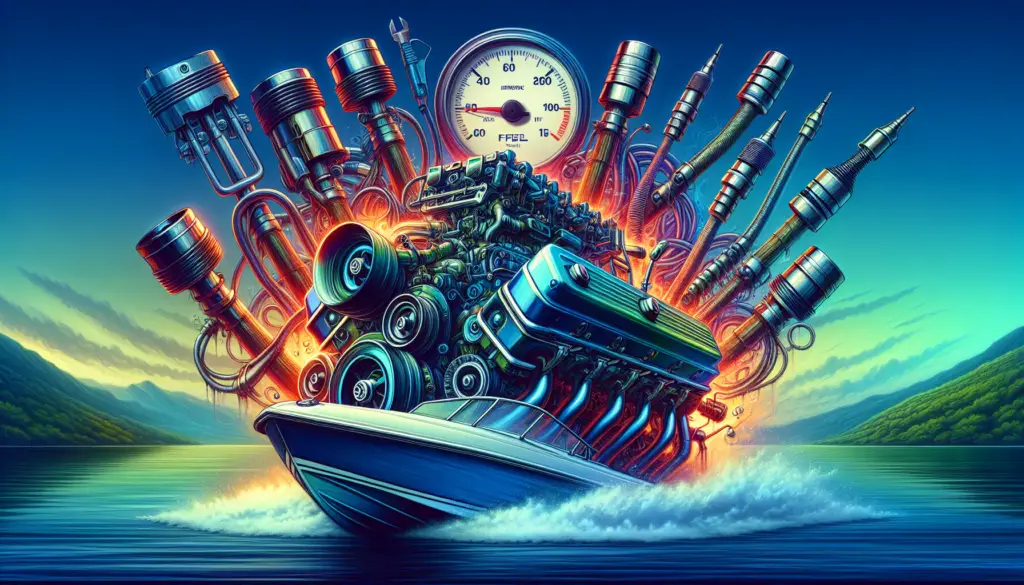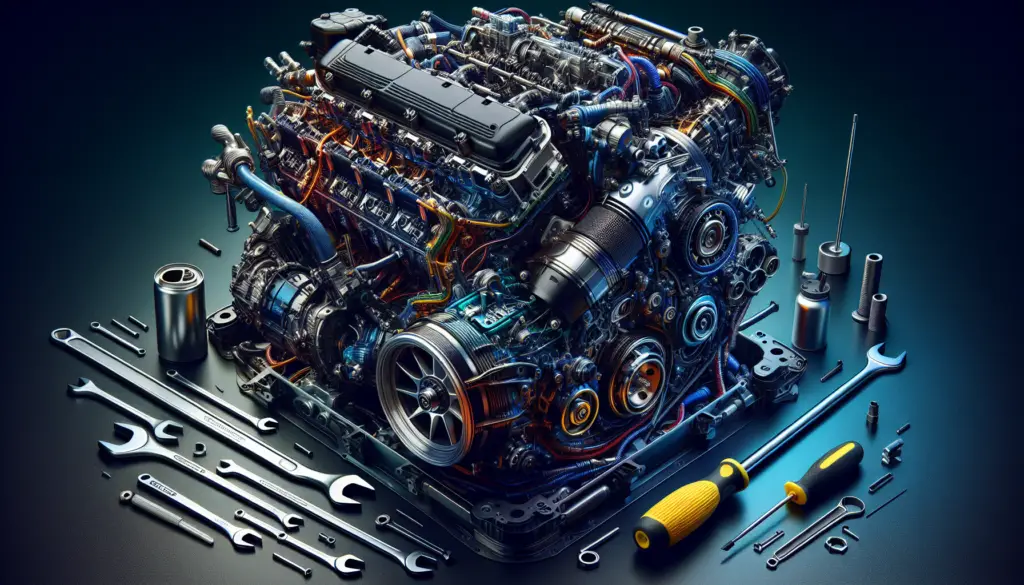If you’re a boat enthusiast looking to enhance your watercraft’s performance, you’re in for a treat. In this article, we’ll explore the most popular boat engine modifications that can take your boating experience to the next level. From increasing horsepower to improving fuel efficiency, these modifications are tried and tested by fellow boaters who have experienced the thrill of upgrading their engines. So sit back, relax, and get ready to discover a world of possibilities for your beloved boat.
1. Performance Enhancements
1.1 Increasing horsepower
When it comes to enhancing the performance of your boat engine, increasing horsepower is a popular modification that can significantly improve the speed and acceleration of your vessel. There are several ways to achieve this, such as upgrading the engine’s components, including the air intake system, exhaust system, and fuel injectors. This allows for a higher flow of air and fuel into the engine, resulting in more power being generated.
1.2 Upgrading fuel system
upgrading the fuel system is another effective way to enhance your boat engine’s performance. This involves replacing the stock fuel injectors with high-performance ones, which can deliver a greater volume of fuel to the engine. Additionally, installing a larger fuel pump that can provide a higher fuel flow rate can also contribute to improved performance. Upgrading the fuel system ensures that the engine receives an adequate supply of fuel, resulting in better combustion and increased power output.
1.3 Installing a supercharger or turbocharger
For those seeking a significant boost in horsepower, installing a supercharger or turbocharger can be a game-changer. Both of these devices compress the incoming air, allowing for a greater amount of oxygen to enter the engine cylinders. This, in turn, increases the fuel combustion efficiency and power output. A supercharger is driven by a belt connected to the engine, while a turbocharger utilizes the engine’s exhaust gases to power a turbine and compress the incoming air. Both options offer a substantial increase in engine performance.
1.4 Tuning the engine for better performance
Fine-tuning the engine is an effective way to optimize its performance. This can be done by adjusting various parameters such as the air-fuel mixture, ignition timing, and valve timing. Professional tuners can utilize specialized software and equipment to make these adjustments, ensuring that the engine is operating at its optimal performance level. Tuning can result in improved horsepower, torque, throttle response, and overall engine efficiency.
2. Fuel Efficiency Improvements
2.1 Adding fuel additives
If you’re looking to improve the fuel efficiency of your boat engine, adding fuel additives can be a simple and cost-effective solution. Fuel additives are specially formulated chemicals designed to enhance the performance of fuel and improve combustion efficiency. They can help to reduce fuel consumption, improve engine responsiveness, and lower emissions. Common types of fuel additives include fuel conditioners, octane boosters, and fuel system cleaners. By adding these additives to your fuel, you can maximize fuel efficiency and save on costs in the long run.
2.2 Installing a fuel flow meter
A fuel flow meter is a device that measures the rate at which fuel is being consumed by the engine. By installing a fuel flow meter, you can monitor your boat’s fuel consumption in real-time and make adjustments accordingly. This information allows you to optimize your cruising speed and throttle position to achieve maximum fuel efficiency. Additionally, a fuel flow meter can help detect any irregularities or potential issues with the fuel system, allowing for timely maintenance or repairs.
2.3 Optimizing fuel system
Optimizing the fuel system is crucial for improving fuel efficiency. This involves ensuring that all components of the fuel system, such as the fuel lines, filters, and injectors, are clean and free from any blockages or deposits. Regular maintenance and inspection of the fuel system can help identify and resolve any issues that may be affecting fuel efficiency. Additionally, upgrading to high-quality fuel filters and using fuel with the correct octane rating can also contribute to improved fuel efficiency.
2.4 Using a propeller with optimal pitch
The choice of propeller can have a significant impact on your boat’s fuel efficiency. Using a propeller with the correct pitch ensures that the engine operates in its optimal RPM range, resulting in improved fuel economy. A propeller with too low of a pitch may cause the engine to work harder, consuming more fuel, while a propeller with too high of a pitch may prevent the engine from reaching its maximum performance. Consulting with an expert or conducting research to determine the ideal propeller pitch for your boat and engine can help maximize fuel efficiency.

3. Noise Reduction
3.1 Soundproofing the engine compartment
If you enjoy peaceful and quiet boating experiences, soundproofing the engine compartment is a modification worth considering. Excessive engine noise can be distracting and affect your overall boating experience. Soundproofing materials, such as acoustic insulation and noise-absorbing foams, can be installed in the engine compartment to reduce noise transmission. Additionally, sealing any gaps or openings in the engine compartment can further minimize noise leakage. By soundproofing the engine compartment, you can create a more pleasant and peaceful boating environment.
3.2 Upgrading exhaust system
One of the primary sources of noise in a boat engine is the exhaust system. Upgrading to a high-quality aftermarket exhaust system can significantly reduce engine noise levels. These systems are designed to minimize noise without compromising engine performance. By replacing the stock mufflers with quieter options and incorporating advanced noise reduction technologies, such as baffles and resonators, you can enjoy a quieter boating experience while still maintaining optimal engine performance.
3.3 Installing a noise reduction system
In addition to soundproofing the engine compartment and upgrading the exhaust system, installing a dedicated noise reduction system can further enhance your boat’s overall noise reduction capabilities. These systems are typically designed specifically for marine applications and utilize advanced noise-cancellation technologies. By actively generating anti-noise signals, these systems can effectively suppress engine noise, providing a more enjoyable and peaceful boating experience.
4. Emission Control
4.1 Adding catalytic converters
To minimize the environmental impact of your boat engine, adding catalytic converters to the exhaust system can be a significant upgrade. Catalytic converters are highly effective at reducing harmful emissions by promoting chemical reactions that convert pollutants into less harmful substances. By installing catalytic converters, you can help reduce the emissions of harmful gases such as carbon monoxide, nitrogen oxides, and hydrocarbons. This not only benefits the environment but also ensures your boat complies with emission regulations.
4.2 Upgrading to a cleaner-burning fuel
Another effective way to reduce emissions from your boat engine is by upgrading to a cleaner-burning fuel. Cleaner-burning fuels, such as ethanol-free gasoline or low-sulfur diesel, produce fewer pollutants during combustion. These fuels have lower levels of harmful substances, such as sulfur and volatile organic compounds, which contribute to air pollution. While cleaner-burning fuels may come at a slightly higher cost, the environmental benefits and potential long-term savings make them a worthwhile investment.
4.3 Installing an EGR system
An Exhaust Gas Recirculation (EGR) system is a device that helps reduce nitrogen oxide emissions from the engine by recirculating a portion of the exhaust gas back into the engine’s intake manifold. This process reduces the combustion temperature and limits the formation of nitrogen oxides, a major contributor to air pollution. Installing an EGR system can help ensure that your boat engine meets emission standards and contributes to cleaner and healthier waterways.

5. Reliability Upgrades
5.1 Upgrading ignition system
To enhance the reliability of your boat engine, upgrading the ignition system is a wise choice. The ignition system is responsible for generating the spark that ignites the air-fuel mixture in the engine cylinders. Upgrading to a high-performance ignition system, such as a modern electronic ignition, can provide more reliable and consistent spark timing. This results in improved engine starting, smoother operation, and increased overall reliability, especially in challenging boating conditions.
5.2 Improving cooling system
A reliable cooling system is vital for preventing engine overheating and maintaining optimal operating temperatures. Upgrading the cooling system can involve installing a more efficient water pump, upgrading the radiator or heat exchanger, or adding additional cooling fans. These upgrades help ensure that the engine stays within its recommended temperature range, even under heavy loads or in hot weather conditions. By improving the cooling system, you can safeguard the engine from potential damage and increase its longevity.
5.3 Enhancing fuel filtration system
The fuel filtration system plays a crucial role in protecting the engine from contaminants that can cause damage or reduce performance. Upgrading to a high-quality fuel filter and incorporating additional filtration stages can enhance the system’s ability to remove impurities and water from the fuel. This helps prevent fuel system problems, such as clogged injectors or fuel pump failures, which can lead to engine damage and poor performance. By ensuring clean and filtered fuel supply, you can enhance the reliability and longevity of your boat engine.
6. Durability Enhancements
6.1 Installing a corrosion protection system
The harsh marine environment can be detrimental to the longevity and performance of your boat engine. Installing a corrosion protection system, such as sacrificial anodes or specialized coatings, can help combat the damaging effects of corrosion. Sacrificial anodes are made from metals that are more reactive than the engine components, effectively sacrificing themselves to protect the engine from corrosion. Coatings, such as ceramic or epoxy-based coatings, create a protective barrier against corrosive elements. By implementing these durability enhancements, you can extend the lifespan of your boat engine.
6.2 Upgrading engine components
Upgrading specific engine components can significantly improve their durability and performance. For example, replacing outdated or worn-out parts with higher-quality components, such as forged pistons, performance camshafts, or stronger connecting rods, can enhance the overall strength and reliability of the engine. Additionally, upgrading to more robust bearings, gaskets, and seals can help prevent leaks and reduce the risk of component failures. By selectively upgrading engine components, you can enhance the durability and performance of your boat engine.
6.3 Adding oil coolers
Installing oil coolers is an effective way to enhance the durability and efficiency of your boat engine. Oil coolers help regulate the temperature of the engine oil by dissipating excess heat, thereby preventing overheating and oil breakdown. This ensures that the engine oil remains within its optimal operating range, providing effective lubrication and minimizing wear on internal engine components. With the addition of oil coolers, you can increase the durability and lifespan of your boat engine, especially during prolonged periods of heavy use.

7. Versatility Modifications
7.1 Adding a trolling motor mount
For anglers and boating enthusiasts who enjoy fishing, adding a trolling motor mount can greatly enhance the versatility of their boat. A trolling motor mount allows you to easily attach and remove a trolling motor, which provides secondary propulsion for slow and precise maneuvering. This is especially useful when fishing in calm waters or when navigating through tight spots. With the ability to switch between your main engine and a trolling motor, you can optimize your boat’s performance for different boating activities.
7.2 Upgrading to a hydraulic jack plate
A hydraulic jack plate is a versatile modification that allows you to adjust the vertical position of your boat’s outboard motor. By raising or lowering the motor, you can optimize your boat’s performance in various water conditions. The ability to fine-tune the engine’s height can improve fuel efficiency, reduce drag, and enhance overall maneuverability. Additionally, a hydraulic jack plate enables you to navigate shallow waters more effectively, as you can raise the motor to avoid grounding. Upgrading to a hydraulic jack plate offers greater flexibility and adaptability for your boat.
7.3 Installing a power trim and tilt system
A power trim and tilt system is a convenient modification that provides effortless control over the trim angle and vertical position of the outboard motor. This feature allows you to adjust the motor’s tilt and trim while underway, optimizing the boat’s performance and ride quality. By adjusting the tilt angle, you can improve fuel efficiency, reduce the boat’s bow rise, and enhance overall stability. The ability to easily trim the engine also enables quick and smooth transitioning between different water conditions, ensuring a comfortable and efficient boating experience.
8. Safety Features
8.1 Installing a kill switch
Safety should always be a top priority when boating, and installing a kill switch is a critical safety feature. A kill switch is a device that automatically shuts off the engine if the operator is unexpectedly thrown from the helm. It is typically connected to a lanyard or wristband worn by the operator. If the operator is separated from the helm, the kill switch will disconnect, stopping the engine and preventing the boat from continuing to operate uncontrolled. Installing a kill switch can help prevent accidents and ensure the safety of everyone on board.
8.2 Upgrading to a hydraulic steering system
Upgrading to a hydraulic steering system can greatly enhance the safety and maneuverability of your boat. Hydraulic steering systems provide effortless and precise steering control, allowing for quick and responsive maneuvering. This is especially beneficial in challenging situations, such as navigating through tight spaces or when encountering rough water conditions. Hydraulic steering eliminates the need for excessive physical effort, reducing operator fatigue and improving overall safety. Upgrading to a hydraulic steering system ensures smooth and reliable steering, enhancing the safety and enjoyment of your boating experience.
8.3 Adding a fire suppression system
Fire safety is of utmost importance on a boat, and adding a fire suppression system provides an extra layer of protection. A fire suppression system is designed to detect and suppress fires in the engine compartment, where most fires originate. It typically consists of an automatic detection system, extinguishing agents, and discharge nozzles. In the event of a fire, the system will activate and release the extinguishing agents, suffocating the fire and preventing its spread. Installing a fire suppression system can significantly reduce the risk of a catastrophic fire and ensure the safety of everyone on board.

9. Convenience Upgrades
9.1 Installing a power anchor winch
Anchoring your boat can be time-consuming and physically demanding, especially in challenging weather conditions or deep waters. Installing a power anchor winch can greatly simplify this process and enhance convenience. A power anchor winch automates the anchoring process, allowing you to effortlessly raise or lower the anchor with the press of a button. This saves you time and effort, making anchoring a hassle-free experience. With a power anchor winch, you can quickly and easily secure your boat in any desired location, maximizing your boating enjoyment.
9.2 Adding an autopilot system
For boaters who frequently navigate long distances or spend extended periods on the water, adding an autopilot system can greatly enhance convenience and comfort. An autopilot system utilizes GPS and other sensors to automatically steer the boat along a pre-set course. This allows the operator to relinquish manual steering control, giving them the freedom to attend to other tasks or simply enjoy the ride. By maintaining a consistent heading and course, an autopilot system reduces operator fatigue and enhances overall safety and convenience during extended boating trips.
9.3 Upgrading to a remote control system
Upgrading to a remote control system provides seamless and convenient control of your boat’s engine and other auxiliary systems. With a remote control system, you can operate the engine, adjust throttle position, engage gears, and control other functions from a handheld remote. This eliminates the need to be solely stationed at the helm, providing greater flexibility and convenience. Additionally, many remote control systems offer features such as engine synchronization and docking mode, facilitating precise maneuvering and enhancing safety during close-quarters navigation.
10. Technology Integration
10.1 Installing a GPS navigation system
Installing a GPS navigation system is a technological advancement that can greatly enhance your boating experience. A GPS navigation system provides accurate positioning and navigation information, allowing you to effectively plan and follow routes. With real-time information on your boat’s location, speed, and direction, you can navigate with confidence, especially in unfamiliar waters. Many GPS systems also offer additional features such as navigational charts, depth sounders, and weather data, further enhancing safety, convenience, and overall boating enjoyment.
10.2 Adding a fishfinder
For anglers, adding a fishfinder to your boat can greatly improve your fishing success. A fishfinder is a sonar device that detects and displays the presence of fish and underwater structures. By transmitting and receiving sound waves, a fishfinder provides valuable information on water depth, fish location, and bottom structure. This enables you to identify productive fishing spots, locate schools of fish, and adjust your fishing strategy accordingly. By adding a fishfinder to your boat, you can significantly enhance your fishing experience and increase your chances of a successful catch.
10.3 Upgrading to a digital control panel
Upgrading to a digital control panel offers advanced functionality and convenience in operating and monitoring your boat’s systems. A digital control panel consolidates various controls and displays into a centralized and user-friendly interface. This allows you to easily monitor and control essential functions such as engine performance, fuel levels, battery status, electrical systems, and even entertainment features. With intuitive graphical interfaces and customizable options, a digital control panel enhances convenience and improves overall boat management. Upgrading to a digital control panel brings your boat’s technology integration to the next level.
In conclusion, there are numerous boat engine modifications available to enhance different aspects of your boating experience. From performance enhancements to fuel efficiency improvements, noise reduction to emission control, reliability upgrades to durability enhancements, versatility modifications to safety features, convenience upgrades to technology integration, each modification serves a specific purpose in optimizing your boat’s performance, functionality, and overall enjoyment. Whether you are an avid angler, a long-distance cruiser, or simply seeking greater convenience and comfort, carefully considering these modifications can make a significant difference in your boating adventures. Remember to consult with professionals, conduct thorough research, and prioritize safety when undertaking any boat engine modifications. Happy boating!


